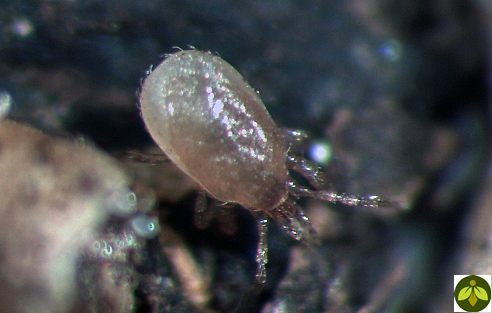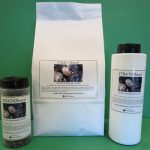General

Stratiolaelaps scimitus (formerly called Hypoaspis miles), is a predatory mite that lives in the top half inch of soil. They are mainly used for the prevention, control, and management of fungus gnats (Sciaridae) and certain thrips species that pupate in the soil/on the ground. This affinity for eating thrips pupae is an underrated benefit of using these mites. Western flower thrips, for example, spend a third of their lives in the soil, and breaking that part of the life cycle has a substantial impact on the overall population. Using only S. scimitus can reduce western flower thrips population by 43%1. They will also eat springtails, and other soil pests.
Description
Newly hatched larvae are lightly colored and have only six legs. After their first molt and into adulthood, they have eight legs. Adult mites are about 0.5 mm and are dark tan to light brown in color. They are oval in shape but slightly tapered towards the front and have small setae (hair-like structures) on their bodies.
Life-History
Eggs are laid in the soil but are unlikely to be seen. These mites have five developmental stages: egg, larva, protonymph, deutonymph, and adult. Larvae do not feed, but every life-stage after is predatory. They will develop at temperatures from 59-86°F, but optimum is around 77°F2. However, they will survive much colder temperatures, although feeding and development will be slowed or halted altogether.
At optimum temperatures, females will lay 2-3 eggs per day. The development time has a very wide range. They can go from egg to adult in as little as 10 days but may take up to 46 in colder temperatures2. They are relatively long-lived for a mite. If food is available, one experiment showed they can live for up to around 142 days3. The same experiment showed that even without food, adults can live for around 24 days, and if fed for six days before food availability is gone, females can live for around 65 days and males for around 45.
Benefits
With the ability to effectively control fungus gnats, shore flies, and the reduction of thrips populations, STRATIOforce™ is one of the pillars of almost any biocontrol program. They are especially effective when used in combination with Dalotia coriaria. As mentioned previously, they are also very persistent in the greenhouse and can sometimes be found months after initial release. For short-term crops, re-application usually only needs to be done if the crop is transplanted (only use half of the original rate after transplant). For longer-term crops, apply every six to eightweeks.
Drawbacks
These mites can’t handle dry soil, so use in certain herbs, cacti, and succulents may not be an option. The good thing is, if the soil is fairly dry, fungus gnats/shore flies should not be much of a problem anyway. They also don’t handle being on rockwool very well, so they can’t be used in hydroponics.
Scouting
They can sometimes be found by picking up a small handful of soil and spreading it across a white sheet of paper, although don’t necessarily expect to find them that way. Like with Dalotia coriaria, another option is to place a slice of potato in the soil. This will attract both fungus gnat larvae and their predators. S. scimitus can sometimes be found on or near the potato slice after a couple/few days. However, what may be the best way to tell if they’re in the crop and doing their jobs is the reduction of pests a few days after release.
Usages
Greenhouses/interiors are where these mites are most often used. However, We’ve heard excellent reports from outdoor nurserymen who’ve had outstanding results.
Release Rates for Stratiolaelaps scimitus
| Classification | Release Information |
|---|---|
| Preventative | 10 per square feet |
| With existing pest populations | 30 per square feet |
| Comments | Friable floor, potting mix, and other locations should be treated as well, not just the planting media. |
Produced in the USA by Beneficial Insectary!
Purchase
References
1) Shengyong Wu, Yulin Gao, Xuenong Xu, Endong Wang, Yujie Wang & Zhongren Lei (2014) Evaluation of Stratiolaelaos scimitus and Neoseiulus barkeri for biological control of thrips on greenhouse cucumbers, Biocontrol Science and Technology, 24:10, 1110-1121, DOI: 10.1080/09583157.2014.924478.
2) Ydergaard, S., Enkegaard, A., and Brodsgaard, H.F. 1997. The predatory mite Hypoaspis miles: temperature dependent life table characterisitcs on a diet of sciarid larvae, Bradysia pauper and B. trictici. Entomologia Experimentalis et Applicata 85: 177-187
3) Wright, E.M. and Chambers, R.J. 1994. The biology of the predatory mite Hypoaspis miles (Acari: Laelapidae), a potential biological control agent of Bradysia pauper (Dipt: Sciaridae). Entomophaga 39: 225-235.

